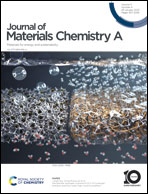An in situ formed copolymer electrolyte with high ionic conductivity and high lithium-ion transference number for dendrite-free solid-state lithium metal batteries†
Abstract
Polymer electrolytes (PEs) synthesized from an in situ polymerization strategy are considered as promising candidates to improve interfacial compatibility. However, most in situ formed PEs still suffer from problems such as low lithium-ion transference number (tLi+) and insufficient ionic conductivity at room temperature (RT). Herein, a series of copolymer electrolytes (CPEs) consisting of 1,3-dioxolane (DOL) and 1,3,5-trioxane (TXE) monomers are synthesized. Due to the additive of succinonitrile (SN), and the promoted dissociation of lithium salt, the obtained polymer electrolyte (SN-CPE) exhibits an excellent ionic conductivity (4.06 × 10−4 S cm−1) and a high lithium-ion transference number (tLi+ = 0.881) at RT, as well as a high voltage oxidation window of 5.1 V. Thanks to the in situ formed intimate contacted electrode/electrolyte interface, the symmetric Li/Li cell can achieve long-term cycling stability over 1500 h without a short circuit. A LiF-rich organic–inorganic composite layer is formed on both the solid electrolyte interphase (SEI) and cathode electrolyte interphase (CEI) as demonstrated by XPS, TEM, and SEM analyses. Thereafter, the LiFePO4/Li cell has a high capacity retention of 84.1% after 900 cycles at RT, and it can still work effectively at high temperatures (e.g. 80 °C). Furthermore, SN-CPE exhibits excellent electrochemical performance and safety in the LiCoO2/Li cell and LiFePO4/graphite pouch cell, which again supports the promising application of SN-CPE.



 Please wait while we load your content...
Please wait while we load your content...